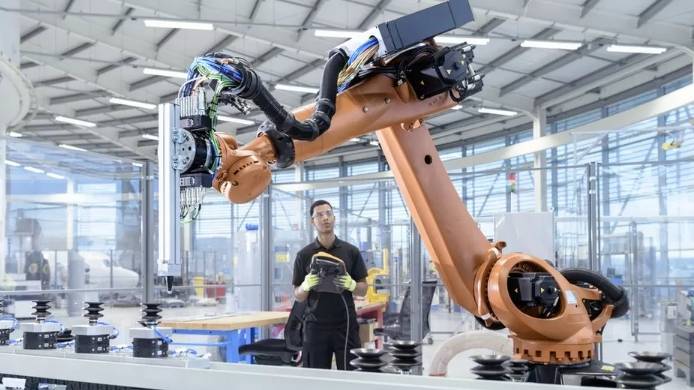
The Enigma of Technology’s Impact on Productivity: Unveiling the Paradox
We are reminded that we are currently experiencing a technological revolution. Computers, the internet, faster communication, data processing, robotics, and the recent addition of artificial intelligence are continuously transforming and enhancing businesses and the world of work.
Despite the rapid advancements in technology, there seems to be a significant gap in the economic data reflecting its impact on making us more productive. The evidence supporting the notion that technology is actually enabling us to work faster and more efficiently remains scarce.
From 1974 to 2008, the UK experienced annual productivity growth of 2.3%, indicating an increase in output per worker. However, between 2008 and 2020, the rate of productivity growth drastically declined to approximately 0.5% per year. Even more concerning, in the first quarter of this year, UK productivity experienced a decline of 0.6% compared to the same period last year.
A similar trend is observed in most other Western countries. For instance, in the US, productivity growth was 3.1% between 1995 and 2005, but it subsequently declined to 1.4% from 2005 to 2019. Despite experiencing a significant period of innovation and technological progress, productivity seems to have slowed down significantly. This apparent paradox raises questions about the factors contributing to this phenomenon.

One possible explanation could be that the abundance of technology has led us to use it as a means to procrastinate and avoid productive work. Activities like constant messaging on Whatsapp, watching YouTube videos, engaging in heated Twitter debates, or mindlessly browsing the internet may be contributing to reduced productivity. However, there could also be more significant underlying factors influencing the slowdown in productivity growth that require deeper examination.
Economists closely scrutinize productivity, acknowledging its complexity. The 2008 financial crisis and the current high inflation are considered factors negatively impacting productivity. Two main explanations are often put forth for why technology fails to boost productivity.
One suggested reason is that we may not be accurately measuring the true impact of technology. Additionally, economic revolutions often take time to unfold, and technological changes may be occurring, but their full benefits might not be realized for decades.

Dame Diane Coyle, the Bennett Professor of Public Policy at the University of Cambridge, is a renowned expert on productivity measurement. She points out that digital technology has become pervasive, but its impact is challenging to discern because it is not adequately reflected in the statistics. The current data collection methods do not provide the necessary insights to understand the full extent of technological influence on productivity.
As an illustration, previously, a company might have invested in its own computer servers and IT department. However, nowadays, many companies opt to outsource these services to cloud-based providers overseas. By doing so, the outsourcing company gains access to top-notch software that is consistently updated, reliable, and cost-effective.
However, from an economic measurement standpoint, this efficient shift makes the company appear smaller rather than larger. Consequently, the investment in its own IT infrastructure, which would have previously been included in its economic growth calculations, is no longer accounted for due to the outsourcing of those services.
Dame Coyle offers a compelling historical example from the 19th Century’s industrial revolution to demonstrate how productivity can be overlooked in statistics. She refers to a fascinating 1885 yearbook of UK statistics, consisting of 120 pages, where the vast majority of content focuses on agriculture. In contrast, only 12 pages cover vital sectors like mines, railways, and cotton mills, highlighting how significant economic developments were not adequately represented in the available data at the time.
During the pinnacle of the industrial revolution, a period often associated with the rise of “dark satanic mills,” a striking disparity existed in the data collected. Surprisingly, 90% of the gathered information centered around an aging and diminishing sector of the economy, while a mere 10% was dedicated to what we now recognize as one of the most significant economic transformations in world history. This stark contrast underscores the challenges in capturing and understanding the true impact of revolutionary changes in the economy during that time.
Dame Coyle aptly expresses that our perception of the economy is often shaped by outdated perspectives rather than reflecting its present reality. Another viewpoint posits that the ongoing technological revolution is indeed underway, but its pace may be more gradual than initially anticipated.
Nick Crafts, an emeritus professor of economic history at the University of Sussex Business School, highlights that the significant shifts in economic performance, often perceived as sudden transformations, actually unfolded over several decades in the past. Similarly, he suggests that the current technological revolution may also be a gradual process, taking time to fully manifest its impact.

According to Crafts, there is a parallel pattern seen in historical examples. James Watt patented his steam engine in 1769, but it took 80 years for the first significant commercial railway, the Liverpool to Manchester line, to open in 1830, and the core railway network to be established by 1850. Similarly, the adoption of electricity follows a comparable timeline: from Thomas Edison’s first public use of the light bulb in 1879 to the electrification of entire countries and the widespread replacement of steam power in manufacturing took at least 40 years. This historical perspective suggests that major technological revolutions may indeed take longer to fully unfold than our immediate expectations.
Currently, we could be experiencing a comparable period of transition, akin to the time between the zenith of steam power and the complete development of electricity. However, those nations and businesses that can effectively and swiftly leverage new technology will likely emerge as winners in the productivity race. As in the past with steam and electricity, success is not solely dependent on the technology itself, but on one’s ability to adeptly use, adapt, and harness it – in essence, the level of skill and expertise in utilizing the technology plays a critical role.
According to Dame Coyle, this trend is already evident. There is mounting evidence that regardless of the type of company, there is a noticeable divergence between those who can effectively utilize technology and those who struggle to do so.
“It appears that companies with highly-skilled personnel, extensive data, and adeptness in using sophisticated software are experiencing a significant boost in productivity. However, within the same sector of the economy, there are other companies that simply lack the capabilities to achieve the same level of productivity,” explains Dame Coyle.
Indeed, the technology itself may not be the main hindrance or solution. The key to achieving high productivity growth lies in the ability of companies to effectively harness and leverage the technology to their advantage. Success will be determined by those who master its utilization and adapt it to their specific needs and processes.

